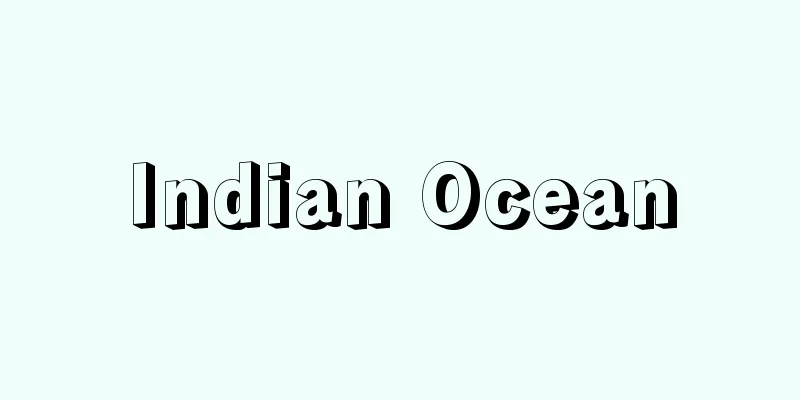Indian Ocean

|
It is one of the three major oceans along with the Pacific and Atlantic Oceans. It is the smallest of the three oceans and is geologically the youngest. [Masao Hanzawa and Kenzo Takano] Scope and sizeIt is an ocean bounded by India, Pakistan, and Bangladesh to the north, the Arabian Peninsula and Africa to the west, the Malay Peninsula, the island chains of Sumatra and Java, and Australia to the east, and Antarctica to the south. The border with the Pacific Ocean is usually taken as the longitude line of Tasmania (147°E), and the border with the Atlantic Ocean is taken as the longitude line of Cape Agulhas (20°E). Including the adjoining seas, the area is about 75 million square kilometers, almost 21% of the total ocean area, the volume is about 290 million cubic kilometers, and the average depth is about 3,900 meters. It is connected to the Persian Gulf, which is an adjoining sea, by the Strait of Hormuz, and to the Red Sea by the Bab el-Mandeb Strait. Because maritime traffic is concentrated in the low latitudes, the Indian Ocean is often thought of as a tropical ocean, but in fact it extends all the way to the Antarctic Circle. [Masao Hanzawa and Kenzo Takano] historyThe ancient name for the Erythraean Sea is thought to refer to the Red Sea, the Persian Gulf, the Arabian Sea, and the present-day northwestern part of the Indian Ocean. One of the great ancient voyages is the return voyage of the Macedonian army of Alexander the Great (356-323 BC) from its expedition to India (327-323 BC). Although the great king was not on board a ship, the voyage lasted five months, traveling down the Indus River, entering the Persian Gulf, and joining the main force returning home by land. There is a theory that the Phoenicians sailed in the Persian Gulf and off the southeastern coast of Africa in the 16th to 15th centuries BC, but the Phoenicians did not leave any records of their voyages, as they did not want other countries to know about the sea routes they had opened, so the extent of their activities is unclear. Hanno the Carthaginian (around 500 BC) is famous for his voyages off the west coast of Africa, but because there were few attractive trade goods in Africa, people's interest turned to the East. Silk, jewels, and spices from Persia, India, and China were highly valued goods. In the Roman era, many ships sailed the Indian Ocean from west to east and from east to west, taking advantage of the seasonal winds and ocean currents. It was already known that sailing farther south and taking advantage of the seasonally changing ocean currents would shorten the voyage time, rather than sailing along the coast. After the fall of the Roman Empire, the Arabs came to have a near monopoly on land and sea routes to the East. Science and technology did not make any great advances in the Middle Ages, but since manpower was no longer as readily available as it had been in the past, people needed to find ways to replace human power with power, and there was progress in the application of science and technology, laying the foundations for the development into modern society. In China, rudders were fixed to the stern of ships in the 7th century, and compasses were widely used in the 12th century. It was in the 12th century that Crusaders (1096-1270) brought magnets from China to Europe via Arabia. It was in the 13th century that compasses were introduced to Northern Europe, and in the 13th century that ships with rudders fixed to the stern were first used in Europe by the Hanseatic League. It had been known since the Phoenician times that the latitude of a place could be determined by measuring the altitude (angle of elevation) of celestial bodies. There were also improvements in the instruments for measuring altitude, and sailing capabilities improved in terms of both ship structure and navigation. Searching for a new sea route to the East, a route not under Arab control, Western Europeans resumed voyages off the west coast of Africa. About 2,000 years had passed since Hanno's voyage. Bartholomeu Diaz (Dias) (c. 1450-1500) rounded the southern tip of Africa and in 1488 became the first European to reach the Indian Ocean side of the continent. He named this southern tip "Cape of Storms", but it was later renamed the Cape of Good Hope by the King of Portugal. Later, Vasco da Gama (1469-1524) reached India in 1498. Voyages by the Portuguese via the Cape of Good Hope increased, disrupting the Arabs' monopoly on trade with the East. This was one of the reasons for the decline of the Arabs' power. Meanwhile, reliable evidence indicates that the first Asian voyage to the Indian Ocean was by Zheng He of the Ming Dynasty. Under orders from the Yongle Emperor, he made seven voyages to the Indian Ocean between 1405 and 1433, visiting the west coast of India, the Persian Gulf, the east coast of Africa, and more. Zheng He's expeditions to the Indian Ocean predated Vasco da Gama by several decades. The oldest clear record of this event in Japan is from 1582 (Tensho 10), when Christian feudal lords Otomo Sorin, Arima Harunobu, and Omura Sumitada sent a mission to the Pope (Tensho Embassy to Europe), with Ito Mancio and Chijiwa Miguel as chief envoys. They crossed the Indian Ocean and arrived in Rome in 1585. On the other hand, little was done on the oceanography of the Indian Ocean until the 19th century. From the mid-19th century to the first half of the 20th century, the British explorer Challenger undertook a major oceanographic expedition, followed by other expeditions by Germany, the Netherlands and other nations. Since the mid-20th century, a number of international collaborative research and surveys have been conducted. [Masao Hanzawa and Kenzo Takano] Submarine topography and geologyThe ocean floor is roughly divided into three parts by ocean ridges. The largest of these is the Central Indian Ridge, which runs in an inverted Y shape from the Gulf of Aden to the central Indian Ocean. In the northeastern part of this ridge is the 90°E Ridge, which runs roughly along the 90°E longitude. Most of the ocean basins separated by these ridges are more than 5,000 meters deep. The Sunda Deep, which runs along Java and Sumatra, is the only deep ocean depth in the Indian Ocean, with a maximum depth of 7,455 meters. The Central Indian Ridge divides the Andaman, Central Indian, Western Australian and South Australian basins in the northeast, the Crozet, Atlantic-Indian and South Indian Basins and the Kerguelen Plateau in the south, and the Somali, Madagascar, Agrias and Cape Basins and the Mascarene Plateau in the northwest. The part of the Mid-Indian Ridge between the Arabian and Somali Basins is called the Carlsberg Ridge. The Red Sea Rift is 2,835 metres deep at its deepest point, but the Bab el-Mandeb Strait, the entrance to the Red Sea, is only 125 metres deep. The deep-sea sediments in the eastern part of the Central Indian Ridge are mainly red clay, Globigerina ooze in the west, and diatom ooze near Antarctica. [Masao Hanzawa and Kenzo Takano] weatherThe weather in the northern and equatorial Indian Ocean is characterized by the presence of seasonal winds (monsoons). In the southern Indian Ocean (Antarctic Ocean), the seasonal change in the atmospheric circulation is small throughout the year. In the Northern Hemisphere winter, from December to February, the equatorial low pressure area is located at approximately 10 degrees south latitude, and is connected to the low pressure area in northern Australia. Meanwhile, there is a strong winter high pressure area in the Asian continent. As a result, strong northeasterly monsoons blow north of the equator. These winds cross the equator and become northwesterly winds before reaching the intratropical convergence zone. The ridge of the subtropical high pressure belt in the Southern Hemisphere is located at approximately 35 degrees south latitude, and strong westerly winds prevail south of 40 degrees south latitude. Many of the low pressure systems circling the Antarctic continent originate and develop here. The roaring forties refers to the storm zone around this area. During the northern hemisphere summer from June to August, a low pressure area with its center near Iran develops over the Asian continent. The ridge of the subtropical high pressure belt in the southern hemisphere is slightly biased to the north and is connected to the high pressure belt in Australia. The southwesterly monsoon blows from south to north around the equator. This monsoon brings a rainy season to India, Bangladesh, Myanmar (Burma), and other countries, bringing heavy precipitation. The winds in the northern hemisphere from June to August are much stronger than in February during the winter. In the southern hemisphere, the westerly wind belt is biased about 5 degrees north, and the westerly winds begin to blow south of about 30 degrees south latitude. During this time, when the southern hemisphere is in winter, the westerly winds around Antarctica are strong. [Masao Hanzawa and Kenzo Takano] Ocean currentsThe ocean circulation in the Indian Ocean is most strongly influenced by the wind system. Strong westerly winds prevail south of 35 degrees south latitude in the Southern Hemisphere, so there is a current from west to east. Around 50 degrees south latitude, where the westerly winds are strongest, the Antarctic Circumpolar Current flows together with the Westerly Wind Current (Westerly Wind Skin Current). In the subtropical waters of the southern Indian Ocean, the ocean circulation is generally counterclockwise. This is made up of the South Equatorial Current, which flows between 10 and 20 degrees south latitude, the Mozambique Current between Madagascar and the African continent, and the Agrias Current (Agullas Current) and Westerly Wind Current, which flow off the coast of South Africa as an extension of this. North of 10 degrees north latitude, the ocean currents vary greatly depending on the season due to seasonal winds. In February, during the northeasterly monsoon, the currents north of the equator are almost westward, and the North Equatorial Current is at its most developed. This current heads south along the coast of Somalia, then turns eastward, becoming the equatorial countercurrent that flows eastward between 2 and 10 degrees south latitude. In August, during the southwesterly monsoon, the South Equatorial Current reaches north of 10 degrees south latitude, and most of it turns north along the coast of Somalia to form the strong Somali Current. North of the equator, it flows generally from west to east. This is called the seasonal wind current (monsoon current). Part of it turns south off the coast of Sumatra, becoming the South Equatorial Current and heading westward. Some coastal areas of the Indian Ocean experience notable upwelling during certain seasons. During the southwest monsoon season from May to September, upwelling is seen in the Banda Sea, off the coast of southern Java, along the coast of Somalia, and off the coast of Arabia. Of these, upwelling is the most pronounced off the coast of Somalia, which is also known as a rich fishing ground due to upwelling. [Masao Hanzawa and Kenzo Takano] water temperatureSea surface temperatures also vary greatly between summer and winter. In February, when the ITCZ is at approximately 10 degrees south latitude, the thermal equator is in the Southern Hemisphere, and the sea surface temperature from the equator to 20 degrees south latitude is about 28°C. In the northern Bay of Bengal and the Arabian Sea, the water temperature is lower, sometimes below 20°C. In the Southern Hemisphere, water temperatures decrease with increasing latitude, but some warm waters exist off the coast of Africa and off the west coast of Australia. The Somali Current carries cold seawater upwelling off the coast of Africa northward. Salinity distribution is determined by evaporation from the ocean surface, precipitation, and inflow of land water, but high salinity areas of 36 psu (psu stands for practical salinity unit) or more are found in the subtropics of the Southern Hemisphere, where evaporation is greater than precipitation. On the other hand, salinity is low around Antarctica due to high precipitation. Salinity is low in the waters along 10 degrees south latitude from Indonesia to Madagascar, where precipitation is high. Salinity in the Bay of Bengal is low due to the inflow of large rivers, sometimes below 30 psu. Salinity is high in the Arabian Sea, where evaporation is active, and can reach 36.5 psu or more in some places. The Persian Gulf (38 psu or more) and the Red Sea (41 psu or more) are high salinity due to the dry climate surrounded by land for the most part. The pattern of salinity distribution does not change much throughout the year. The tidal range during spring tides is large along the Arabian Sea coast, reaching 1.4 meters in Aden and 3.4 meters in Mumbai (Bombay). The tidal range is large around the Bay of Bengal, and is particularly large along the coast of Burma, reaching 7 meters. Along the coasts of Sumatra and Java, the tidal range is 1 to 2 meters, but on the west coast of Australia it is large, reaching 6 to 10 meters. In many places along the coast of South Africa the tidal range is 1.5 to 2 meters, but in the Mozambique Channel it can reach 3 to 5 meters. [Masao Hanzawa and Kenzo Takano] "Japanese Adventures and Exploration" by Kazutoshi Nagasawa (1973, Hakusuisha Publishing) " "Civilizations Created by the Sea: The History of the Indian Ocean Region" by Hikoichi Ieshima (1993, Asahi Shimbun Publishing) " "Monsoon Cultural Region" edited by Keiichi Omoto et al. (2000, Iwanami Shoten) [References] | | | | |©Shogakukan "> Indian Ocean bathymetry map Source: Shogakukan Encyclopedia Nipponica About Encyclopedia Nipponica Information | Legend |
|
太平洋、大西洋と並ぶ三大洋の一つ。三大洋中最小で、地質的にもっとも若い。 [半澤正男・高野健三] 範囲と大きさ北はインド、パキスタン、バングラデシュ、西はアラビア半島およびアフリカ、東はマレー半島、スマトラ、ジャワの列島線およびオーストラリア、南は南極大陸に囲まれた海洋である。太平洋との境界は通常便宜的にタスマニアの経度線(東経147度)、大西洋との境界はアガラス岬(アグリアス岬)の経度線(東経20度)である。付属海も含めると面積は約7500万平方キロメートルで全海洋面積のほぼ21%、容積は約2億9000万立方キロメートル、平均の深さは約3900メートルである。付属海のペルシア湾とはホルムズ海峡で、紅海とはバブ・エル・マンデブ海峡でつながっている。低緯度海域に海上交通が集中しているので、インド洋は熱帯の海と考えられやすいが、実際は南極圏まで広がっている。 [半澤正男・高野健三] 歴史古名をエリトラ海(エリトレア海)Erythraean Seaというが、これは、紅海、ペルシア湾、アラビア海と、現在のインド洋北西部をさしたものと考えられている。古代の大航海としては、マケドニアのアレクサンドロス大王(紀元前356―前323)の軍隊のインド遠征(紀元前327~前323)からの帰航がある。大王が船に乗っていたわけではないが、インダス川を下ってペルシア湾に入り、陸路を帰国中の本隊に合流するまで5か月に及ぶ航海だったという。これよりも前、紀元前16~前15世紀にフェニキア人はペルシア湾やアフリカ東南部沖を航海していたという説があるが、フェニキア人は彼らが開いた航路をほかの国々に知られることを嫌って航海記録を残していないので、その活動状況は明らかではない。 アフリカ沖については、カルタゴ人ハンノ(紀元前500年ころ)の西岸沖航海が名高いが、アフリカには魅力のある交易商品が乏しかったので、人々の関心は東方に向かった。ペルシア、インド、中国などの絹、宝石、香辛料は価値の高い商品だった。ローマ時代には多数の船が季節風と海流を利用してインド洋を西から東へ、東から西へ航行していた。海岸沿いに航行するよりも、ずっと南に航路をとって、季節風と季節によって変わる海流を利用するほうが航海日数が短くなることはすでに知られていた。 ローマ帝国が滅びると、アラビア人が東方への陸路と海路をほぼ独占することになった。中世に科学・技術は著しく進歩したわけではないが、人手が以前ほど得やすい社会ではなくなったため、人力を動力でおきかえる工夫が必要となり、科学・技術の応用面では進展があり、近代社会へ発展するための基礎が固められていった。中国では7世紀に舵(かじ)が船尾材に固定され、12世紀には羅針盤が広く使われていた。十字軍(1096~1270)がアラビアを経て中国からヨーロッパへ磁石を伝えたのが12世紀である。北ヨーロッパに羅針盤が導入されたのは13世紀であり、船尾材に舵を固定した船がヨーロッパで初めてハンザ同盟で使われたのも13世紀である。ある場所の緯度を知るには天体の高度(仰角)を測ればよいことはフェニキアの昔から知られていた。高度を測る器具にも改良があって、船体構造と航海術の両面で帆走能力は高まった。 東方への新しい航路――アラビア人の支配下にない航路――を求めて西ヨーロッパ人はアフリカ西沖航海を再開した。ハンノの航海から約2000年もたっていた。ディアスBartholomeu Diaz (Dias)(1450ころ―1500)は、アフリカ南端をまわって1488年に大陸のインド洋側にヨーロッパ人としては初めて到達した。彼はこの南端を「嵐の岬」と名づけたが、のちにポルトガル王の命名で喜望峰となった。そのあと、ガマVasco da Gama(1469―1524)は1498年にインドに到達した。ポルトガル人らによる喜望峰沖経由の航海は増え、東方交易でのアラビア人の独占を阻んだ。これがアラビア人の勢力衰退の一因となった。 一方、東洋人の最初のインド洋航海は、確実な資料では、明(みん)の鄭和(ていわ)による。永楽帝の命を受け、1405~33年の間に7回にわたりインド洋を航海し、インド西岸、ペルシア湾、アフリカ東岸などに遠征した。鄭和隊のインド洋航海はバスコ・ダ・ガマよりも数十年早い。 日本で、記録がはっきり残っていてもっとも古いのは1582年(天正10)、キリシタン大名の大友宗麟(そうりん)、有馬晴信、大村純忠(すみただ)が、伊東マンショ、千々石(ちぢわ)ミゲルを正使とする使節団(天正遣欧使節)をローマ法王に送った航海である。彼らはインド洋を横断し、85年にローマ入りをしている。 一方、インド洋の海洋学的解明は19世紀に至るまでほとんど行われなかった。19世紀中葉から20世紀前半にかけて、イギリスのチャレンジャー号による海洋大探検ののち、ドイツ、オランダなどの海洋探検がある。20世紀なかばからはいくつもの国際共同研究・調査が行われている。 [半澤正男・高野健三] 海底地形と地質海洋底は海嶺(かいれい)によって大きく三つの部分に分けられている。海嶺のうち最大のものは中央インド洋海嶺で、アデン湾からインド洋中央部に逆Y字形に走っている。この海嶺の北東部分には、ほぼ東経90度に沿う東経九十度海嶺がある。これらの海嶺によって分かれた海盆の深さは、ほとんどが5000メートル以上である。ジャワ、スマトラに沿って走るスンダ海淵(かいえん)はインド洋における唯一の海淵で、最深部の深さは7455メートルである。 中央インド洋海嶺によって分けられた北東部には、アンダマン、中央インド洋、西オーストラリア、南オーストラリア海盆が、南部にはクローゼー、大西洋・インド洋、南インド洋海盆とケルゲレン海台が、北西部にはソマリ、マダガスカル、アグリアス、ケープ海盆とマスカリーン海台がある。アラビア海盆とソマリ海盆との間にある中央海嶺の一部はカールスベルク海嶺とよばれる。紅海裂谷の最深部は2835メートルであるが、紅海の入口バブ・エル・マンデブ海峡の深さは125メートルにすぎない。中央インド洋海嶺東部の深海堆積(たいせき)物は、主として赤粘土、西部はグロビゲリナ軟泥、南極大陸の近くは珪藻(けいそう)軟泥である。 [半澤正男・高野健三] 気象インド洋の北部および赤道域の気象の特徴は、季節風(モンスーン)の存在である。インド洋南部(南極海)では年間を通じ大気環流の季節変化は小さい。 北半球の冬、すなわち12月から2月まで赤道域の低圧部はほぼ南緯10度にあり、北オーストラリアの低圧部とつながっている。一方、アジア大陸には強い勢力の冬の高気圧がある。この結果、赤道以北では強い北東の季節風が吹く。これは赤道を越え、熱帯内収束帯に達する前に北西風となる。南半球の亜熱帯高圧帯の尾根は南緯35度付近にあり、南緯40度以南では強い西風が卓越する。南極大陸周辺を回る低気圧の多くはここで発生し、発達する。「ほえる40度」the roaring fortiesとはこの付辺の暴風圏のことをいう。 6月から8月の北半球の夏には、イラン付近に中心をもつ低圧部がアジア大陸に発達する。南半球の亜熱帯高圧帯の尾根はやや北に偏り、オーストラリアの高圧帯とつながっている。赤道を南から北に南西季節風が吹く。この季節風はインド、バングラデシュ、ミャンマー(ビルマ)などに雨期をもたらし、多量の降水をもたらす。6月から8月にかけての北半球の風は、冬期の2月に比べはるかに強い。南半球においては西風帯は約5度北に偏り、偏西風は南緯30度あたり以南で吹くようになる。そして南半球が冬であるこの時期、南極大陸周辺の西風は強い。 [半澤正男・高野健三] 海流インド洋の海洋循環は風系にもっとも強く影響されている。南半球の南緯35度以南では強い西風が卓越しているため、西から東へ向かう流れがある。西風がもっとも強くなる南緯50度付近では周南極海流が西風海流(西風皮流)とともに流れている。南インド洋の亜熱帯海域では海洋の循環はおおむね反時計回りである。これは、南緯10~20度を流れる南赤道海流、マダガスカル島とアフリカ大陸の間のモザンビーク海流、その延長で南アフリカ沖を流れるアグリアス海流(アガラス海流)と西風海流からなる。 北緯10度以北では季節風のため海流の様相は季節によりまったく異なる。2月、すなわち北東季節風の時期、赤道以北の流れはほぼ西向きで、北赤道海流がもっとも発達する。これはソマリア沿岸で南に向かい、さらに東に向きを変え、南緯2~10度を東向きに流れる赤道反流となる。8月、すなわち南西季節風のときは、南赤道海流は南緯10度以北にまで達し、その大部分はソマリア沿岸で北転して強いソマリ海流を形成する。赤道以北ではおおむね西から東に流れる。これを季節風海流(モンスーン海流)という。その一部はスマトラ島沖で南転し、南赤道海流となって西に向かう。 インド洋の沿岸部では季節によっては顕著な湧昇(ゆうしょう)がみられる所がある。5月から9月の南西季節風の時期には、湧昇はバンダ海、ジャワ島南沖、ソマリア沿岸およびアラビア沖にみられる。このうちもっとも著しいのはソマリア沖のもので、この海域は湧昇に伴う豊かな漁場としても知られている。 [半澤正男・高野健三] 水温海面水温の様相も夏と冬で大きく異なる。2月、熱帯内収束帯がほぼ南緯10度にあるとき、熱赤道は南半球にあり、赤道から南緯20度までの海面水温は約28℃である。ベンガル湾北部やアラビア海では水温はこれより低く、20℃以下の所もある。南半球では、水温は緯度が高くなるとともに低下するが、アフリカ沖とオーストラリア西岸沖には一部に温暖水が存在する。 ソマリ海流はアフリカ沖の湧昇による冷たい海水を北に運ぶ。塩分の分布は海面からの蒸発、降水、陸水の流入によって決まるが、36psu(psuはpractical salinity unitの略、実用塩分単位)以上の高塩分域は、蒸発量が降水量より多い南半球の亜熱帯域に存在する。一方、南極大陸周辺では降水量が多いため塩分は低い。インドネシア海域からマダガスカル島に至る南緯10度に沿う海域では降水量が多いため、塩分は低い。ベンガル湾は巨大河川の流入のため塩分は低く、ときに30psu以下となる。蒸発の盛んなアラビア海では塩分が高く、36.5psu以上となる所もある。ペルシア湾(38psu以上)や紅海(41psu以上)は大半を陸地に囲まれた乾燥気候の影響で高塩分を示す。年間を通じ塩分分布のパターンの変化は小さい。 潮汐(ちょうせき)大潮の潮差はアラビア海沿岸で大きく、アデンで1.4メートル、ムンバイ(ボンベイ)で3.4メートルである。ベンガル湾一帯は潮差が大で、ビルマ沿岸はとくに大きく7メートルに達する。スマトラ、ジャワ沿岸では1~2メートルであるが、オーストラリア西岸では大きく6~10メートルである。南アフリカ沿岸の潮差は1.5~2メートルの所が多いが、モザンビーク海峡では3~5メートルに達する。 [半澤正男・高野健三] 『長沢和俊著『日本人の冒険と探検』(1973・白水社)』▽『家島彦一著『海が創る文明――インド洋海域世界の歴史』(1993・朝日新聞社)』▽『尾本惠市他編『モンスーン文化圏』(2000・岩波書店)』 [参照項目] | | | | |©Shogakukan"> インド洋の海底地形図 出典 小学館 日本大百科全書(ニッポニカ)日本大百科全書(ニッポニカ)について 情報 | 凡例 |
Recommend
Tokumoto Pass - Tokugo Pass
A pass located in the east of Mt. Kasumizawa in t...
Roasted sweet potato - Yakiimo
〘Noun〙 Roasted sweet potatoes. 《Season: Winter》※Hy...
Medical Social Worker
...The former refers to social welfare, social se...
Gurukuma - Gurukuma (English name) pigmy mackerel
A marine fish of the Scombridae family in the orde...
Eliseev
A Japanese scholar born in Russia. He studied Japa...
Caribbean Current
…The temperature is about 25-28°C in the south of...
X organ - sinus gland system
…Although it is called a gland, it is not an inde...
Yukata (Japanese summer kimono) - Yukata
A single-layer summer home wear made from cotton y...
River Tyne
A river that flows through Northumberland and Tyne...
Coastal current - Kaiganryu
…It is important because it transports sand from ...
pous
...There are two types of notation: instrumental ...
Kuwata Kumazo
A leading social policy scholar of the Meiji and ...
Onomatopoeia - Onomatopoeia
…Onomatopoeia, which imitate the sounds of the ou...
Inga Kozou
A title for Kabuki and Joruri. Original title Ryus...
Yoshinobori (common freshwater goby)
A fish of the family Goby in the order Perciformes...









